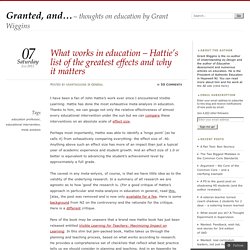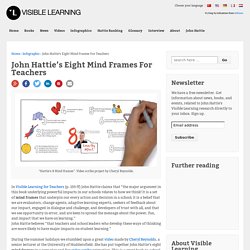

What works in education – Hattie’s list of the greatest effects and why it matters. I have been a fan of John Hattie’s work ever since I encountered Visible Learning.

Hattie has done the most exhaustive meta-analysis in education. Thanks to him, we can gauge not only the relative effectiveness of almost every educational intervention under the sun but we can compare these interventions on an absolute scale of effect size. Perhaps most importantly, Hattie was able to identify a ‘hinge point’ (as he calls it) from exhaustively comparing everything: the effect size of .40. Anything above such an effect size has more of an impact than just a typical year of academic experience and student growth.
And an effect size of 1.0 or better is equivalent to advancing the student’s achievement level by approximately a full grade. The caveat in any meta-anlysis, of course, is that we have little idea as to the validity of the underlying research. Can you guess the next two items on the rank order list? “Home environment” and “socio-economic status.” Like this: Like Loading... Glossary of Hattie's influences on student achievement. This Glossary explains influences related to student achievement published in John Hattie’s Visible Learning for teachers (Hattie 2012; 251ff).

You can find an older list of influences related to student achievement in Hattie (2009) Visible Learning. 1. Student Self-Reported Grades Self reported grades comes out at the top of all influences. Children are the most accurate when predicting how they will perform. Example for Self-reported grades: Before an exam, ask your class to write down what mark the student expects to achieve.
Hattie cites five meta-studies: Mabe/West (1982): Validity of self-evaluation of ability (Abstract)Fachikov/Boud (1989): Student Self-Assessment in Higher Education (Abstract)Ross (1998): Self-assessment in second language testing (Abstract)Falchikov/Goldfinch (2000): Student Peer Assessment in Higher Education (Abstract)Kuncel/Crede/Thomas (2005); The Validity of Self-Reported Grade Point Averages, Class Ranks, and Test Scores (Abstract) 2. 3. 4. 5.
John Hattie's Eight Mind Frames For Teachers. “Hattie’s 8 Mind frames”.

Video scribe project by Cheryl Reynolds. In Visible Learning for Teachers (p. 159 ff) John Hattie claims that “the major argument in this book underlying powerful impacts in our schools relates to how we think! It is a set of mind frames that underpin our every action and decision in a school; it is a belief that we are evaluators, change agents, adaptive learning experts, seekers of feedback about our impact, engaged in dialogue and challenge, and developers of trust with all, and that we see opportunity in error, and are keen to spread the message about the power, fun, and impact that we have on learning.” John Hattie believes “that teachers and school leaders who develop these ways of thinking are more likely to have major impacts on student learning.” During the summer holidays we stumbled upon a great video made by Cheryl Reynolds, a senior lecturer at the University of Huddersfield. Teachers toolbox - Professor John Hattie's Table of Effect Sizes.
Hattie says ‘effect sizes' are the best way of answering the question ‘what has the greatest influence on student learning?

'. An effect-size of 1.0 is typically associated with: • advancing learners' achievement by one year, or improving the rate of learning by 50% • a correlation between some variable (e.g., amount of homework) and achievement of approximately .50. Motivating Students With Effective Feedback and Clarity. Visible Learning: John Hattie and Student-Directed Projects - Teaching Ahead: A Roundtable. Visible Learning for Teachers: Maximizing Impact on Learning : John Hattie : 9780415690157. Making learning Visible (John Hattie) Auckland University Professor John Hattie has recently authored a study, based on research into 83 million students, studying effective teachers around the world and has come up with some reassuring results for creative teachers.

It's all about trusting relationships and 'oodles of feedback'. Note - it is not about national testing, our government's highly unoriginal plan. Click here for latest blogA link For more undated thinking about Hattie It seems hard to avoid the brief press releases of Auckland University Professor John Hattie's research in our newspapers. It is a shame that the papers haven't done more in depth research of their own into Hattie's findings. Most teachers by now will know the main findings of Hattie's research from his previous papers and creative teachers will be reassured that his research backs up intuitive ideas gained from their experience. He also says that his book is not about qualitative studies.
Welcome to Visible Learning Plus. John Hattie, Visible Learning. Pt 2: effective methods. John Hattie: Visible Learning Pt1. Disasters and below average methods. What works best. This page has now been revised (May 2010) in the light of John Hattie's recent apparently definitive work Visible Learning; a synthesis of over 800 meta-analyses relating to achievement (London; Routledge, 2009).

The first thing to change has been the title, which used to be "What works and what doesn't". Hattie points out that in education most things work, more or less. The questions are around those which work best and therefore best repay the effort invested. This site is mainly about your own individual practice as a teacher, and as such it tries to take into account your particular circumstances, such as the students you teach (assumed largely to be over school-age), your subject, your setting (school, college, university, work-based or informal adult education).
It recognises that it is difficult and even unreasonable to generalise, but we ought to set alongside this the results of very generalised research in the form of meta-analyses. Hattie's concept of visible teaching and learning. Visible Learning. Hattie's 8 Mindframes. Visible Learning - An Interview with Dr. John Hattie. Summary of Visible learning for teachers.
Information About What Works Best For Learning. Vialogues : Meaningful discussions around video. Why are so many of our teachers and schools so successful? John Hattie at TEDxNorrkoping. Visible Learning - Panel Discussion with Dr. John Hattie.